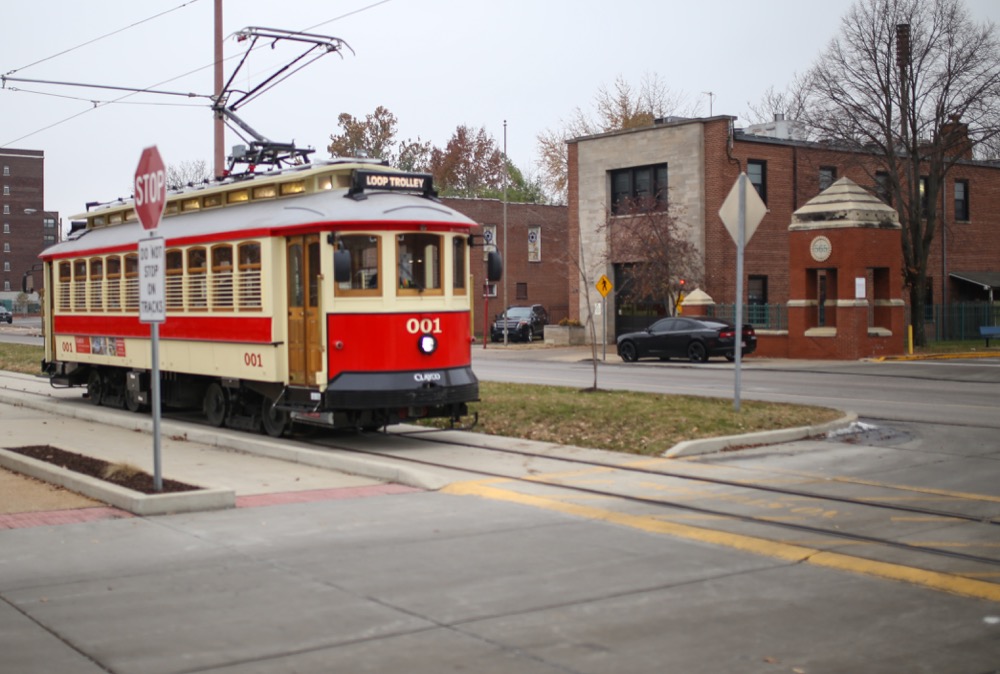News
Loop Trolley partially up and running despite various issues
After almost four years of construction and a host of complications, the opening ceremony of the Delmar Loop Trolley went ahead in Delmar Hall Thursday, although a winter weather advisory delayed its actual first run to Friday.
University City currently bars the trolley from the first four stops of the route, located in the city, until it provides a $300,000 bond as insurance to the city in case the trolley system folds.
 Grace Bruton | Student Life
Grace Bruton | Student Life The Delmar Loop Trolley runs along the Delmar/DeBaliviere corridor. After the trolley’s first run was postponed due to snow Thursday, ongoing permitting issues meant that it did not actually run on Delmar Boulevard during its initial trips this weekend.
The trolley has faced criticism throughout its construction, and two parked cars have been involved in collisions with the trolley in the past month alone. Additionally, the trolley was halted by crime scene tape after a volley of gunfire resulting from an apparent road-rage incident near the tracks on Friday afternoon. There were no injuries reported.
The Delmar Loop Trolley was originally envisioned by developer Joe Edwards, the owner of Blueberry Hill, Peacock Diner and other Loop mainstays. Edwards has been the main force behind the Loop’s transformation from a deserted retail district in the 1970s to a bustling tourist attraction.
The trolley line had a total construction budget of $51 million. Washington University made two contributions to the trolley project that amounted to $250,000. Funds were raised over a five-year period starting in 2010 before construction broke ground in 2015.
Edwards believes that the trolley will be compatible with shifting attitudes about transportation among younger generations.
“Many young people now want electric transit and environmentally-sound transit, and also many want to live in livable and walkable communities. It enriches people’s lives by giving them more flexibility without having to drive around in circles looking for parking,” Edwards said.
Edwards says that the University has an active presence in its immediate surroundings.
“Wash. U. has been very supportive of the Delmar Loop and other surrounding communities. They’ve been great, great neighbors and supporters of things that happen here,” Edwards said.
According to Vice Chancellor for Public Affairs Jill Friedman, the University supported the trolley at its initial stages.
“During the beginning phase of the project, Washington University supported the construction of the Loop Trolley,” Friedman wrote in a statement to Student Life. “The Loop Trolley connects many important entertainment destinations including the Delmar Loop, Forest Park and the Missouri History Museum, and provides residents and visitors with a convenient public transit option in the Delmar/DeBaliviere corridor.”
Friedman did not comment on how the trolley might affect students who live on the Delmar Loop.
Junior Kevin Kanter, who lives in the Lofts on the Delmar Loop, believes that the trolley could impede traffic.
“Just the very nature of it, because it takes up a third lane, I think it will slow down traffic,” Kanter said. “I drive to school every day and if there’s even one person turning, it’s a whole hold-up.”
The 2.2-mile long line of service runs from the University City Library to Forest Park, with eight stops in between. A two-hour pass will cost two dollars and an all-day ticket with unlimited rides will cost five dollars.
